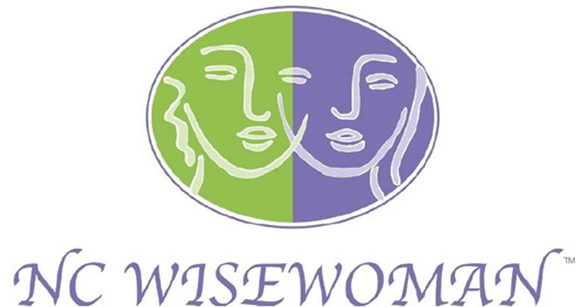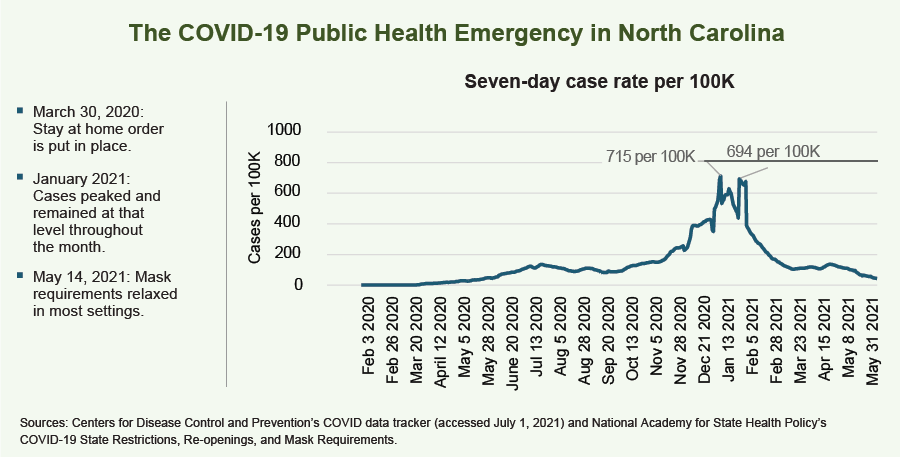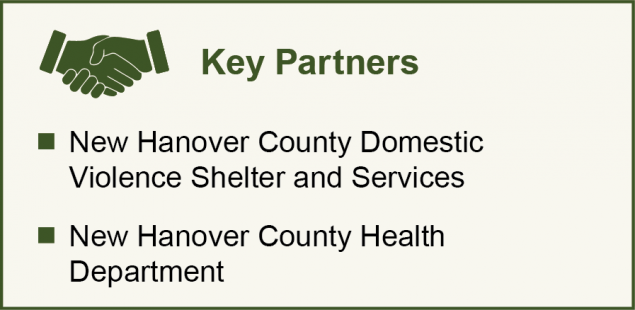Conducting WISEWOMAN Outreach at a Domestic Violence Shelter in North Carolina
WISEWOMAN Innovation Spotlight

North Carolina’s WISEWOMAN program has an innovative approach that seeks to conduct outreach to women at domestic violence shelters and link eligible women to WISEWOMAN cardiovascular education and screening services. North Carolina began implementation at the beginning of the COVID public health emergency in 2020. Figure 1 displays COVID case rates and timing of public health protective measures as important context that influenced the recipient’s program implementation progress.
- 1,951 women served, including 1,467 with a complete high blood pressure screening
- 64% of women identify as Hispanic, Black or African American, Asian or Pacific Islander, American Indian or Alaska Native, or multiracial
- 30% of women had hypertension at baseline screening
Source: Mathematica’s analysis of minimum data elements for women with a complete or high blood pressure screening in Years 1 and 2 (September 2018 to September 2020).
Notes: The national WISEWOMAN program defines hypertension as having an average systolic blood pressure of 140 mm Hg or higher, having an average diastolic blood pressure of 90 mm Hg or higher, or taking medication for high blood pressure.
How It Works
North Carolina partnered with New Hanover County’s Domestic Violence Shelter and Services to identify women from the shelter and refer them to the WISEWOMAN program.
The recipient worked with the shelter to establish blood pressure screening stations where women could measure their blood pressure and complete a cardiovascular screening questionnaire, which includes a checkbox to select whether the woman would like additional information about the WISEWOMAN program.
The COVID-19 pandemic, which began in March 2020 and peaked in early 2021 (see Key Partners box), resulted in a domestic violence crisis that overwhelmed the shelter, forcing staff to put all nonessential activities on hold, pausing activity on the innovative work indefinitely.
I think one of the biggest successes…was just the planning efforts for all the agencies, including the DV [domestic violence] Shelter, the New Hanover County Health Department. The cross-training of one another’s services is productive. Again, their enthusiasm, their eagerness, all those things I think was such a success. And I think that’s what made us more determined to find ways in which we can move forward.
Achievements to Date
Established a protocol for conducting outreach to women in domestic violence shelters. North Carolina program staff said they worked closely with New Hanover County Domestic Violence Shelter and Services to learn about this population and develop protocols to reach and engage these women in WISEWOMAN services.
Developed training materials on the innovative approach. In November 2019, North Carolina trained 24 staff from the New Hanover County Health Department and Domestic Violence Shelter and Services on the WISEWOMAN program. Although it is uncertain whether the recipient will move forward with its partnership with the New Hanover County shelter, the recipient believes the foundational work to develop workflows, trainings, and protocols can be leveraged with future partners.
Figure 1. The COVID-19 Public Health Emergency in North Carolina, February 2020 to May 2021

This graph titled The COVID-19 Public Health Emergency in North Carolina, charts the seven-day case rate per 100 thousand people, February 3, 2020, through May 31, 2021. The case rate remained close to zero from February 3 to May 5, 2020. A stay at home order was put in place on March 30. Beginning in May, case rates began to increase but remained below 200 per 100 thousand until November, when they began to rise sharply. Cases peaked in January 2021 and remained level throughout the month (between 694 and 715 per 100 thousand). Case rates began to fall off sharply in February, dropping to nearly zero by May 31. Mask requirements were relaxed in most settings on May 14. Sources: Centers for Disease Control and Prevention’s COVID data tracker (accessed July 1, 2021) and National Academy for State Health Policy’s COVID-19 State Restrictions, Re-openings, and Mask Requirements.
Related Resources
Other Organizations
References
- Centers for Disease Control and Prevention. COVID Data Tracker. Atlanta, GA: U.S. Department of Health and Human Services, CDC. Accessed July 1, 2021.
- National Academy for State Health Policy. 2020 COVID-19 State Restrictions, Re-openings, and Mask Requirements. Accessed July 1, 2021.

